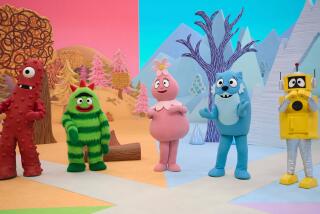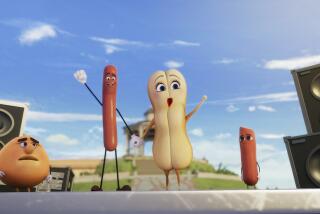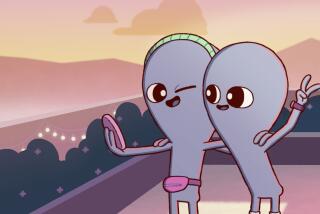‘SpongeBob SquarePants’ Is Soaking Up Some Fun
If you doubt that “SpongeBob SquarePants” has become a major underwater force in the TV cartoon world, well, you’re all wet.
SpongeBob is the lovable, earnest sponge who lives in a pineapple at the bottom of the ocean. He also is the current star of the phylum porifera, for all you fans who like to mix a little biology with your cartoon viewing pleasure.
Nickelodeon has declared this “SpongeBob Summer,” with the half-hour show going prime time Monday through Thursday.
How many other rectangular yellow guys have a coterie of fans such as Jerry Lewis, Tony Bennett, Dr. Dre, Sigourney Weaver, Tom Waits and Will Ferrell? Rob Lowe, whose son is a fan, was photographed in the June issue of In Style magazine next to a big plush likeness of the absorbent yellow fellow. And Lance Bass of the band ‘N Sync has made a couch of out of SpongeBob toys (perhaps during those idle hours on tour).
“A lot of people seem to be interested in it, and it seems to be the show getting all the buzz, not just from little kids but from bigger kids, even,” said Timothy Burke, a cultural historian and assistant professor at Swarthmore College.
More than 28 million people tune in every month, hoisting SpongeBob by his square brown trousers to the second-highest-rated property on kids’ TV. (“Rugrats,” another Nickelodeon show, is first.) But only 17.5 million of those are kids; 3.7 million teenagers watch the show, along with 9.8 million adults.
“My 63-year-old surgeon father loves SpongeBob as much as my kids,” one viewer wrote on an Internet fan site. Another wrote that his office mate canceled his satellite dish because he couldn’t get the show.
Only a few children’s shows--among them “Ren & Stimpy” and “Pee-wee’s Playhouse,” both no longer in production, and “Rugrats” and “Powerpuff Girls”--have had such crossover age-group success.
So what’s the big draw? On one Web site, SpongeBob was described as a “wet Uncle Milty,” a reference to Milton Berle’s pioneering 1950s show. That’s close, in that the show is clean and goes for wide humor.
Burke thinks the show works because it’s “surreal and has an interesting weirdness factor to it” in a mellow way, reminiscent of the old “Beany and Cecil” series by Bob Clampett.
“They both had very strange plots, but they are gentle in their strangeness,” as opposed to the fast-paced dementia of “Ren & Stimpy,” said Burke, co-author, with his brother, of “Saturday Morning Fever.”
“SpongeBob” was created by Stephen Hillenberg, who is also its executive producer and a former creative director of “Rocko’s Modern Life,” the story of a perplexed wallaby. The show is very much a product of Hillenberg’s education and interests. A 1992 graduate of the master’s program at California Institute of the Arts in experimental animation, Hillenberg, 39, received an undergraduate degree in natural science with an emphasis on marine biology.
At some point, he says, science was thrown out the window in “SpongeBob.” “By taking the [sponge] character and making it square goes against everything I’ve learned and tried to teach kids,” he said. But the shape fit the character best--a squeaky clean, go-getter--and it was funny, he said.
“SpongeBob SquarePants” is basically a six-character show (if you count SpongeBob’s pet snail, Gary) with other creatures added to the mix every week.
The shows teach lessons, as learned the hard way by SpongeBob and his pals. (For example: Don’t steal; that’s what SpongeBob finds out when he and his friend Patrick Starfish steal a balloon from a vendor and suffer pangs of conscience, only to learn it was Free Balloon Day.)
Visually, it’s as innovative as “Ren & Stimpy” (which Hillenberg lists among his artistic influences), although in a different way. Where “Ren” went for bizarre, “SpongeBob” goes for whimsy with visual humor sophisticated enough to appeal to adults.
Part of the show’s appeal may be its lack of viciousness, according to Joshua Meyrowitz, professor of media studies at the University of New Hampshire and author of “No Sense of Place: The Impact of Electronic Media on Social Behavior.” “I think people hunger for some of the safety of the past, when things were simpler and when people didn’t make fun of everybody else, when there was some sense of boundaries.”
More to Read
The complete guide to home viewing
Get Screen Gab for everything about the TV shows and streaming movies everyone’s talking about.
You may occasionally receive promotional content from the Los Angeles Times.






